Enhancing Procedure Cart Security and Workflow

Before purchasing electronic locking carts for a new department, it is important to consider how employee workflow will be impacted. Our article below, “Enhancing Hospital Efficiency: Advantages of Wi-Fi Capable Electronic Locks on Procedure Carts”, strives to shed some light on this topic.
Electronic locks have become increasingly more popular as hospitals address medication security concerns. Electronic locks allow for automatic relocking – the ability to restrict access to specific users as well as the capture of audit trails that can show who has accessed a given cart. Audit trails give vital information that helps to enhance the security of medications, syringes, and other “at risk” supply items (saline flushes, etc.).
As evidence of this trend, we are seeing carts previously considered “low-risk” for pilferage (such as phlebotomy carts and bedside carts), are now being ordered in greater frequency with electronic locks. Typically, these carts were not subject to the same stringent security standards as anesthesia carts and other carts that store narcotics, but several states and accrediting agencies are taking a stronger stance on medication/procedure cart security and hospitals are being held to a higher standard of security.
But while you consider the cart, it is important to also keep in mind the workflow of the individual(s) who will be managing your fleet (adding/deleting users, modifying relock timers, downloading audit trails, etc.). Carts with Wi-Fi capable locks can be managed remotely, while non-Wi-Fi electronic locks will require physical interaction to make changes or pull audit trails. How long will it take your fleet manager to make updates and access lock data logs to your fleet of carts? This is a question that should be addressed before selecting which electronic lock option will be ideal for your situation. Our advanced electronic locks can function stand-alone or can be connected to a network depending on your needs. For larger fleets, Wi-Fi connected carts will likely be the most efficient solution, while for smaller fleets, our stand-alone electronic locks might be more appropriate. Our team of experts can help you assess your situation and suggest an optimal solution from our product line.
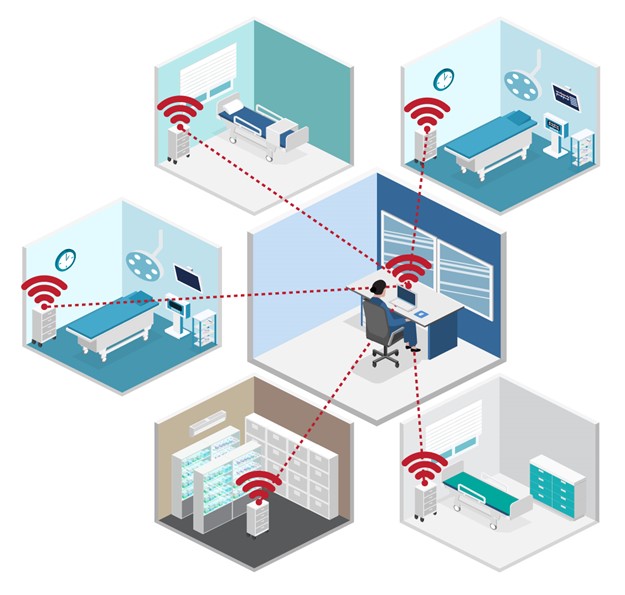
Finally, we cannot overstate the importance of getting your IT department involved VERY early in the investigation process when considering electronic locks. It is absolutely vital to ensure you select the right electronic lock and supporting software that will facilitate an efficient workflow for your team.
As always, thank you for your continued business and we hope you find the information in this newsletter informative!

Enhancing Hospital Efficiency: Advantages of Wi-Fi-Capable Electronic Locks on Procedure Carts
Electronic locks are a great solution for addressing pilferage issues with your procedure carts. However, what often gets overlooked is the question of how efficiently a new fleet of electronic locking procedure carts will be to manage on an ongoing basis. In this article, we are going to shed some light on workflow with various e-locking options and hopefully help illustrate the value of Wi-Fi-capable electronic locks on your fleet of procedure carts.
There is an increased focus on securing medications and other vital supplies on procedure carts throughout hospitals. Drug diversion is certainly a hot topic in healthcare and facilities are leveraging the features of available electronic locks on their procedure carts to address diversion concerns. Electronic locks provide several powerful features that can help address drug and supply diversion in a hospital.
Key electronic lock features include:
- Tracking who has gained access to the cart
- Tracking failed attempts to access the cart
- Restricting specific users from accessing a particular cart or carts
- Creating schedules that allow users access during specific days/times
- Adjustable auto-relock timer that relocks the cart after a preset period of time
The advantages of electronic locks on procedure carts are undeniable. They are a vital tool to helping prevent pilferage of controlled substances or other at-risk supplies such as syringes, and other medications. Audit trails bring accountability which has a very positive impact on reducing diversion of drugs and supplies. But let’s take a closer look at the available electronic lock options and how they impact the workflow of the person who will be responsible for managing your new fleet of electronic locking carts. Before you decide on an electronic lock, you should consider the role of your fleet manager (the person who will be charged with managing the access rights of users, cart lock settings, and audit trails.
So, let’s dig in…
Wi-Fi or Not?
Should you go with WIFI carts that can connect to your network or not?
Key points of consideration…
- How large will your cart fleet be?
- How spread out across your facility will your fleet be?
- How often will you need to add/delete users?
- How often will you need to download audit trails showing who has been in/out of a given cart?
- How often will you need to change auto-relock timers or other lock settings?
- Does your budget allow for Wi-Fi?
- Wi-Fi cannot be added in the field, so this option needs to be considered at the initial purchase of your fleet of carts
When considering whether to add Wi-Fi capability to your new electronic locking medical carts, you need to analyze the workflow of your fleet manager. This person will need to interact with each cart whenever any of the following actions need to be performed.
- Adding/Deleting a new authorized user
- Adding/Deleting a new authorizer supervisor
- Downloading audit trails (showing the history of successful and unsuccessful attempts to unlock cart)
- Change auto-relock timer (cart locks after 10 minutes by default)
- Change access schedule (can adjust who has access to the cart on various days/hours)
How often you expect to be performing the above functions will determine the viability of adding Wi-Fi to your carts?
Simply put…with Wi-Fi capable locks, all updates listed above can be performed at a remote computer and pushed out to your fleet. By comparison, any updates needed on a non-Wi-Fi cart must be performed AT THE CART which may require significant travel time for your fleet manager tasked with managing your carts.
Let’s take a look at illustrations of three potential scenarios when it comes to electronic lock options:
- Scenario#1: Non-Wi-Fi electronic lock programming everything using the numeric keypad on the cart
- Scenario#2: Non-Wi-Fi electronic lock using LockManager software running on a laptop that is carried cart to cart
- Scenario#3: Wi-Fi-capable electronic locking cart and LockManager software operated remotely
For all three scenarios, we are going to make some assumptions in terms of time needed to make lock changes at the cart or via LockManager software as well as travel time from cart to cart. Those assumed values will remain the same across all three scenarios so we can illustrate the time required for each scenario.
SCENARIO#1: Non-Wi-Fi E-Lock
ALL FUNCTIONS MUST BE PHYSICALLY PERFORMED AT EACH CART
- 15 minutes to make changes at each cart using lock keypad
- 2 min travel time between carts
Customer with standard electronic locking carts (no Wi-Fi capability), that manages users and lock functions at the cart without the benefit of LockManager software. This customer will have to travel from cart to cart and spend extra time at each cart using the cart keypad to add/delete users and change lock settings. This is the least efficient fleet management scenario, but for small fleets of carts where audit trails may not be required, it could be the most economical solution.
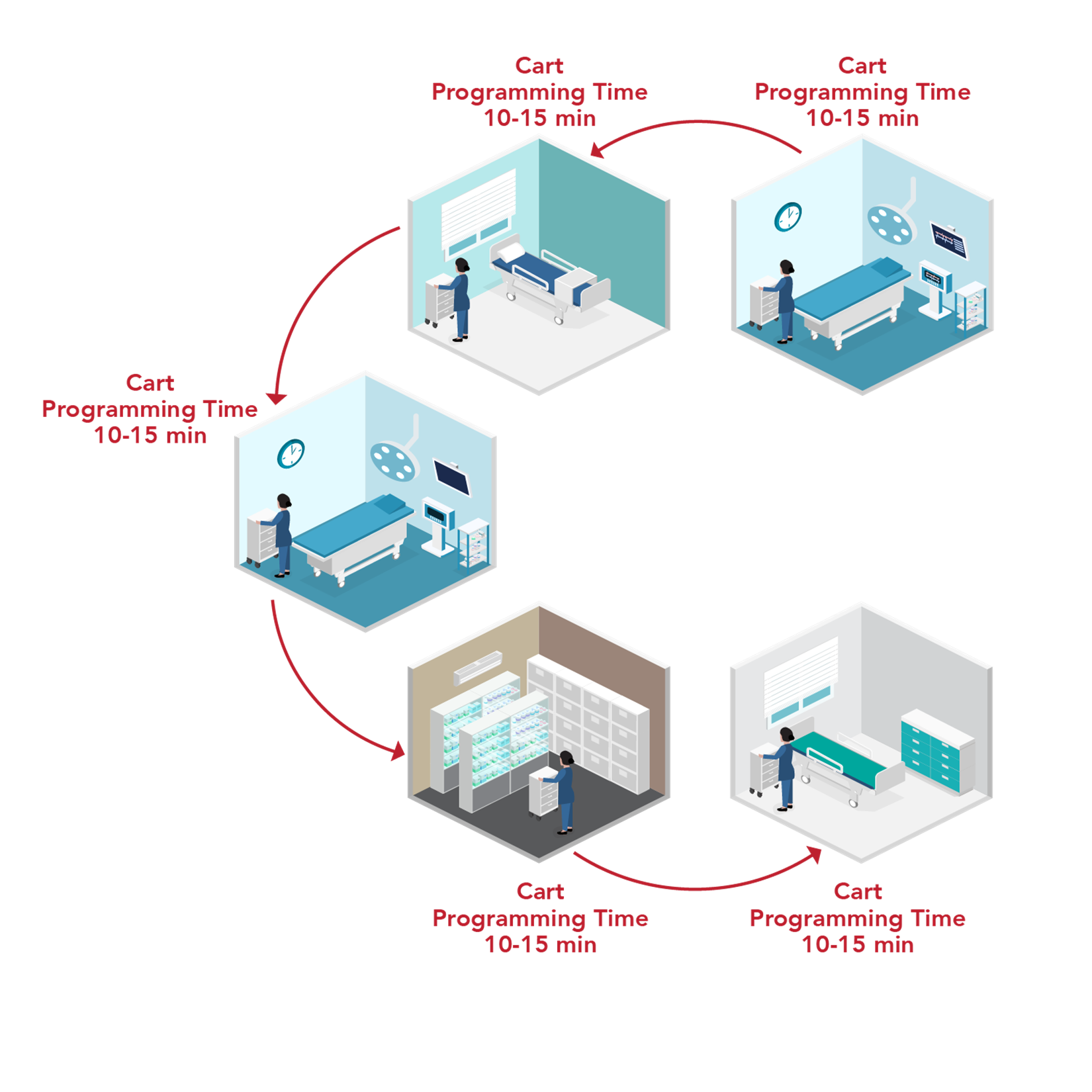
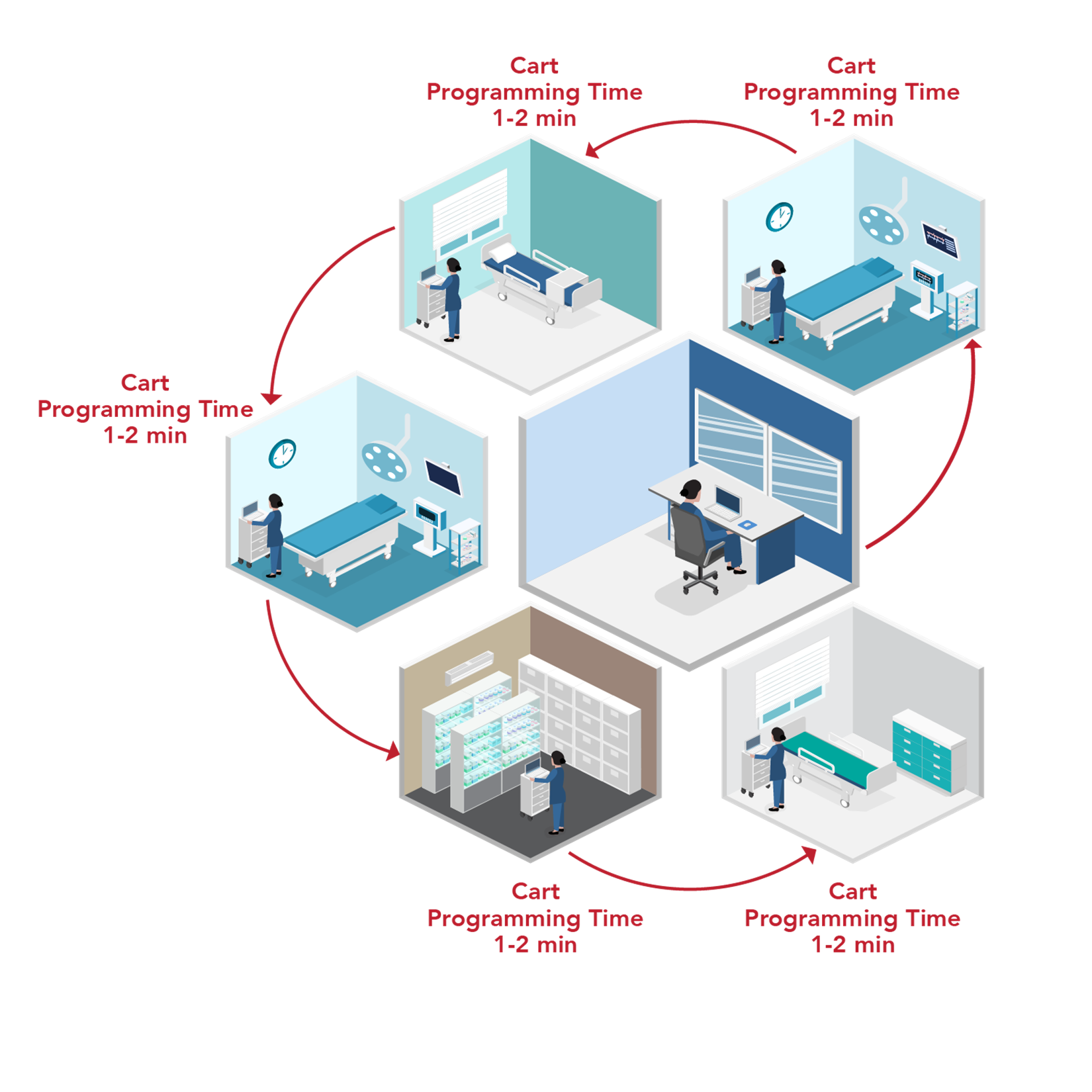
SCENARIO#2: Non-Wi-Fi E-Lock with LockManager
FUNCTIONS CAN BE EXECUTED IN LOCKMANAGER FIRST BUT THE DATA MUST BE UPLOADED PHYSICALLY AT EACH CART
- 20 min to make changes to LockManager software database on laptop
- 2 min upload at each cart
- 2 min travel time between carts
Customer with standard electronic locking carts (no Wi-Fi capability), that manages users and lock functions at each cart via LockManager software on a laptop. This customer will first make lock updates for each cart using their laptop. They will then travel from cart to cart and plug in a data cable between the laptop and the cart to upload the updates. This dramatically shortens the length of time needed at each cart to make updates as all updates are entered at the laptop prior to visiting each cart. This is moderately more efficient than scenario#1 and can be effective on small to mid-sized cart fleets.
SCENARIO#3: Wi-Fi E-Lock with Lock manager
ALL FUNCTIONS CAN BE EXECUTED AND UPLOADED TO EACH CART REMOTELY VIA LOCK MANAGER
- 20 min to make changes to LockManager software database on laptop
- No travel time
Customer with Wi-Fi-capable electronic locking carts that manages users and lock functions for each cart via LockManager software on a laptop. This customer makes lock updates for each cart at their laptop via LockManager software and simply pushes them out to the fleet via Wi-Fi. This SIGNIFICANTLY shortens the length of time needed to make fleet updates. This is the ideal solution for larger fleets of carts where audit trails may be required more frequently.
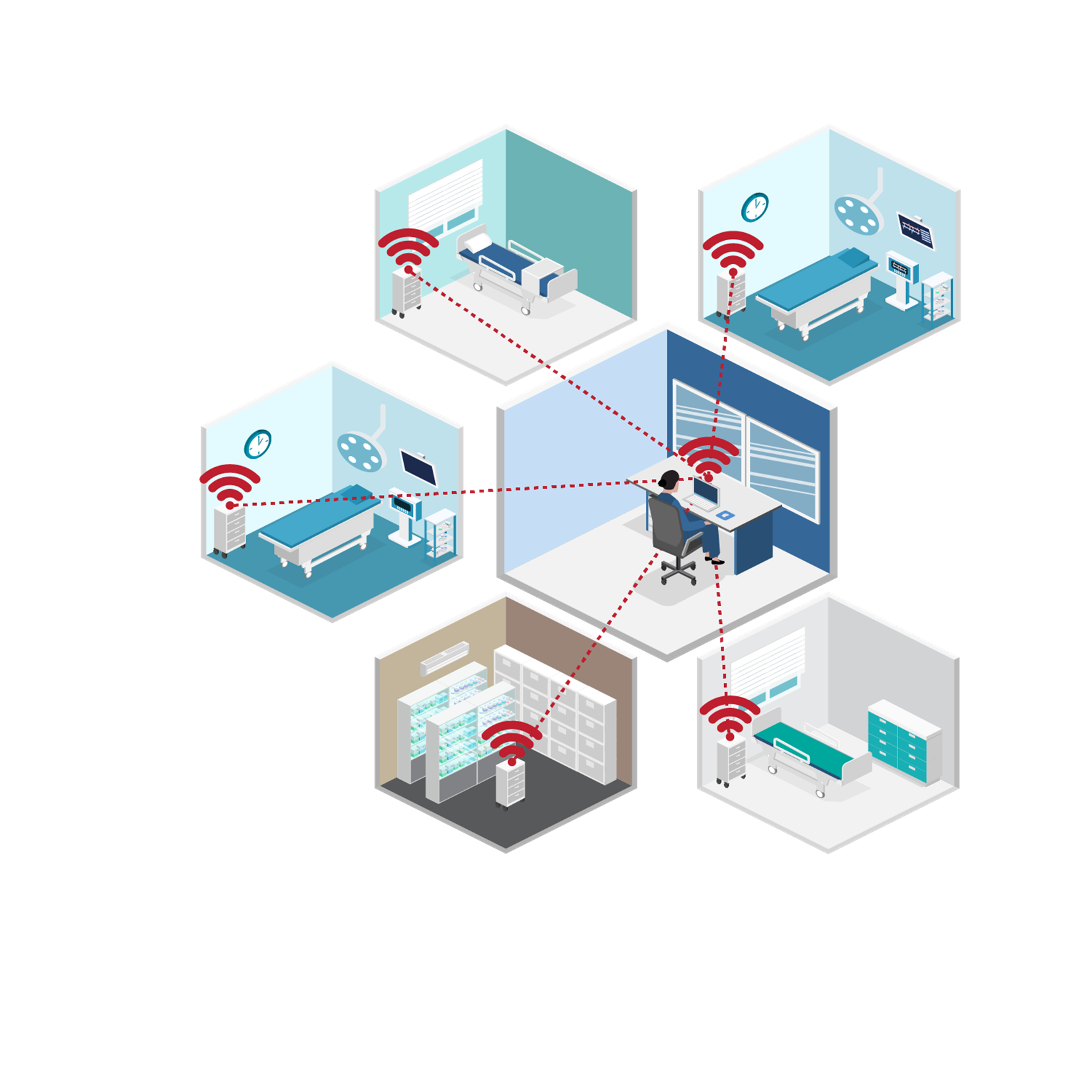
Time Savings Analysis: Non-Wi-Fi vs Wi-Fi
Example 1: Fleet of 10 Carts
- Non-Wi-Fi E-Lock System
- 15 minutes to make changes at each cart using lock keypad
- 2 min travel time between carts
- 170 minutes total to update all locks
- Non-Wi-Fi E-Lock System with LockManager
- 20 min to make changes to LockManager software database on laptop
- 2 min upload at each cart
- 2 min travel time between carts
- 60 minutes total to update all locks
- Wi-Fi E-Lock System with LockManager
- 20 min to make changes to LockManager software database on laptop
- No travel time
- 20 minutes total to update all locks
Example 2: Fleet of 100 Carts
- Non-Wi-Fi E-Lock System
- 15 minutes to make changes at each cart using lock keypad
- 2 min travel time between carts
- 1700 minutes (28.33 hours) total to update all locks
- Non-Wi-Fi E-Lock System with LockManager
-
- 20 min to make changes to LockManager software database on laptop
- 2 min upload at each cart
- 2 min travel time between carts
- 420 minutes (7 hours) total to update all locks
- Wi-Fi E-Lock System with LockManager
-
- 20 min to make changes to LockManager software database on laptop
- No travel time
- 20 minutes total to update all locks
Looking at EXAMPLE 1 and EXAMPLE 2 above you’ll see the distinct time advantage afforded by Wi-Fi when you compare the last bullet point in each scenario against each other. A fleet of 10 carts would take 170 minutes to update (Non-Wi-Fi) vs 20 minutes (Wi-Fi). Look at how dramatically that math changes when you increase the fleet to 100 carts? It’s 1700 minutes to update (Non-Wi-Fi) vs 20 minutes to update (Wi-Fi).
In summary, there is no “one size fits all” solution with your electronic lock configuration. It all depends on individual needs and requirements. The important thing is to consider the back-end management of your electronic locking carts BEFORE you invest in new electronic locking carts. At Waterloo Healthcare, our team of experts are trained to help walk you through the process of finding the optimal lock configuration for your application. Give us a call and we’ll be happy to help you navigate through the various lock options.
History of Locks on Cabinets and Drawers
Apparently, humans have never been very trusting of their fellow humans. The earliest known locking device dates to 4000 B.C. at the site of a former palace in Iraq in the Kingdom of Assyria.
Throughout history, humanity has found some ingenious ways to keep people out of their stuff. In India, valuables were sealed into large blocks of wood and placed on small islands or submerged in pools of the inner courts of the palace and guarded by hungry crocodiles. Intricately tied rope knots created by King Gordius became symbols of security in Phrygia (modern day Turkey). Of course, when Alexander the Great failed to untie the Gordian Knot, he just cut it with a sword.
The first mechanical locks were made of wood and date back 4,000 years and were found in Egypt. The locks fastened vertically on a door post and contained movable pins or pin tumblers that dropped by gravity into openings in the cross piece or bolt.

The first instance of all-metal mechanical locks dates to the Roman era. The locks were created with wards (obstructions) to prevent tampering. The Romans kept their valuables in secure locked boxes and wore the keys as rings on their fingers as a symbol of their wealth and status.
Over the centuries, locks became more ornate, although little changed with the mechanisms themselves. When lock-picking became prevalent in the 18th century, inventors met the challenge by creating increasingly complicated locks, including changeable bits, curtain close-outs around keyholes, alarm bells, puzzles, ring padlocks, and so much more.
The lever tumbler lock was invented by Robert Barron in 1778, and improved upon by Jeremiah Chubb, who developed the Chubb detector lock to frustrate burglars at the Portsmouth Dockyard in Britain. In 1848, Linus Yale improved upon the design of Abraham Stansbury and developed a cylindrical key with precise notches that moved metal slides to turn the bolt and open the lock.
The majority of all locking mechanisms today are still variants of the designs of the 1800s. However, electronic locks have now entered the picture and include keycards, digital locks, and even the newest twist — Wi-Fi enabled electronic signals to allow one or more locks to be opened by remote — although the lock mechanisms themselves are still based on Barron, Chubb, and Yale designs.

Come and see Waterloo’s latest Code Carts and Isolation Carts on display at our booth and the booths of the world’s best healthcare equipment distributors.
DATES: April 21-23, 2024
LOCATION: Las Vegas, Nevada
CONVENTION CENTER: Caesars Forum | 3911 S Koval Ln
Introducing Waterloo Healthcare Heavy Equipment Side Shelf
Waterloo Healthcare’s heavy equipment side shelf is designed to mount heavy equipment to the side of our Steel or Aluminum carts. This frees up workspace on the cart top while providing easy access to vital support equipment.
Can be mounted to either side of a Waterloo Healthcare Steel or Aluminum cart and is a great solution for mounting Medical label Printers, Defibrillators, Light Sources, etc.
Combine with our hospital grade power strip (OS-1) and cord wrap (CW-1) and your cart can become a mobile workstation for a variety of applications.
- Dimensions: 17.72” L x 13.94” W x 15.27” H
- Load Rating: 25 lbs.
- Part# SA-00008
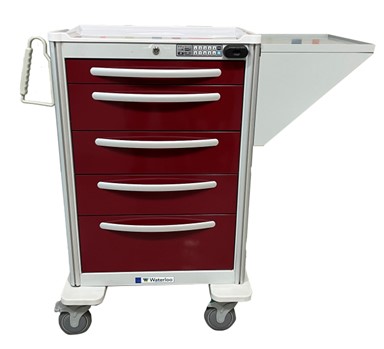
Waterloo Healthcare is dedicated to providing quality, flexible medical cart solutions that accommodate any clinician’s needs, and our team is always available to help design the cart that’s right for you!









